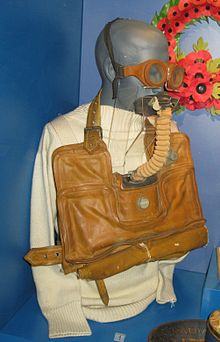- Davis Submerged Escape Apparatus
-
The Davis Submerged Escape Apparatus (also referred to as DSEA), was an early type of oxygen rebreather invented in 1910 by Sir Robert Davis, head of Siebe Gorman and Co. Ltd., inspired by the earlier Fleuss system.[1][2] While intended primarily as an emergency escape apparatus for Royal Navy submarine crews, it was sometimes used for diving and as an industrial breathing set.
The DSEA rig comprises a rubber breathing/buoyancy bag, which contains a canister of barium hydroxide to scrub exhaled CO2 and, in a pocket at the lower end of the bag, a steel pressure cylinder holding approx. 56 litres of oxygen at a pressure of 120 bar. The cylinder is equipped with a control valve and is connected to the breathing bag. Opening the cylinder's valve admits oxygen to the bag and charges it to the pressure of the surrounding water.
The canister of CO2 absorbent inside the breathing bag is connected to a mouthpiece by a flexible corrugated tube; breathing is carried out by the mouth only, the nose being closed by a clip. Goggles are also provided as a standard part of the apparatus.
The breathing/buoyancy bag is fitted with a non-return release valve which allows air to escape from the bag as the user ascends towards the surface and the water pressure decreases. The wearer can close this valve on reaching the surface, the air in the breathing/buoyancy bag then serving as a life preserver. If the bag becomes deflated while the wearer is on the surface awaiting rescue, it can be refilled (for use as a lifejacket) by opening the non-return valve and blowing through the mouthpiece.
The usual Royal Navy DSEA rig also included an emergency buoyancy bag on the front of the main breathing/buoyancy bag to help keep the wearer afloat after reaching the surface even if he had exhausted the air in the breathing/buoyancy bag. This emergency bag was inflated by an "Oxylet" canister inside it - a small steel oxygen cylinder which was opened by breaking its weakened neck and wrenching sharply.
It also had a speed-retarding drogue, which was a rubber apron unrolled and held out horizontally by the wearer as he ascended, dramatically reducing his speed of ascent through water resistance.
Adopted by the Royal Navy in 1929, DSEA was used with limited success to assist crew members to escape from several sunken submarines, for example HMS Poseidon in 1931,[3] HMS Thetis in 1939[4] and HMS Perseus in 1941.[5]
A small version of the DSEA, the Amphibious Tank Escape Apparatus (ATEA) was produced for use by the crews of amphibious DD tanks such as those used during the Normandy landings.
There were instances, mostly during WWII, of the DSEA being used for swimming down from the surface, i.e. for early scuba diving. It was also worn by frogmen piloting the Sleeping Beauty.
The Davis Submerged Escape Apparatus was the first or nearly the first rebreather to be made in quantity.
See also
- escape set, including history.
External links
References
- ^ Davis, RH (1955). Deep Diving and Submarine Operations (6th ed.). Tolworth, Surbiton, Surrey: Siebe Gorman & Company Ltd. p. 693.
- ^ Quick, D. (1970). "A History Of Closed Circuit Oxygen Underwater Breathing Apparatus". Royal Australian Navy, School of Underwater Medicine. RANSUM-1-70. http://archive.rubicon-foundation.org/4960. Retrieved 2009-03-16.
- ^ Paul Kemp (1990). The T-Class submarine - The Classic British Design. Arms and Armour. p. 105. ISBN 0-85368-958-X.
- ^ "Thetis - close enough to touch". Cyberheritage. http://www.cyber-heritage.co.uk/thetis_close_enough_to_touch.htm. Retrieved 2006-12-02.
- ^ "The great escape". Divernet. http://www.divernetxtra.com/wrecks/perse898.htm. Retrieved 2006-12-02.
Categories:- Rebreathers
- Submarine rescue equipment
Wikimedia Foundation. 2010.

